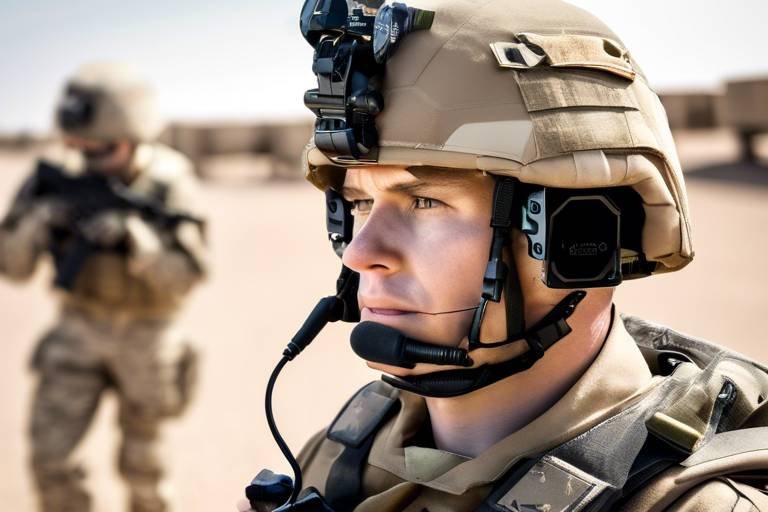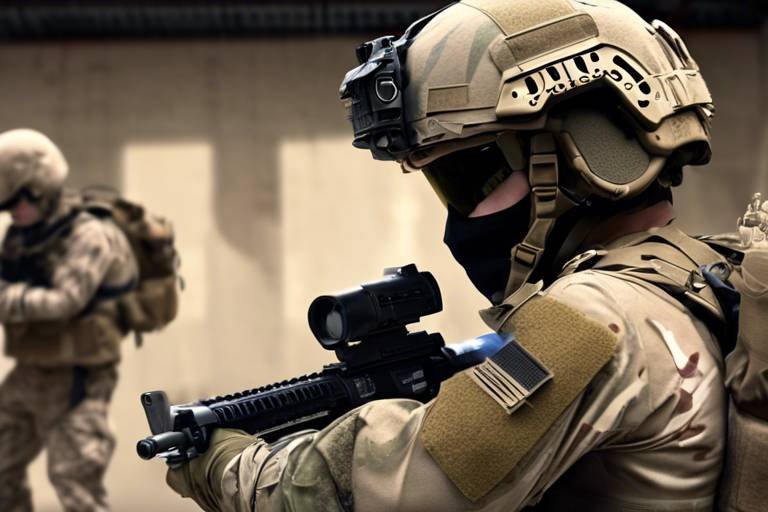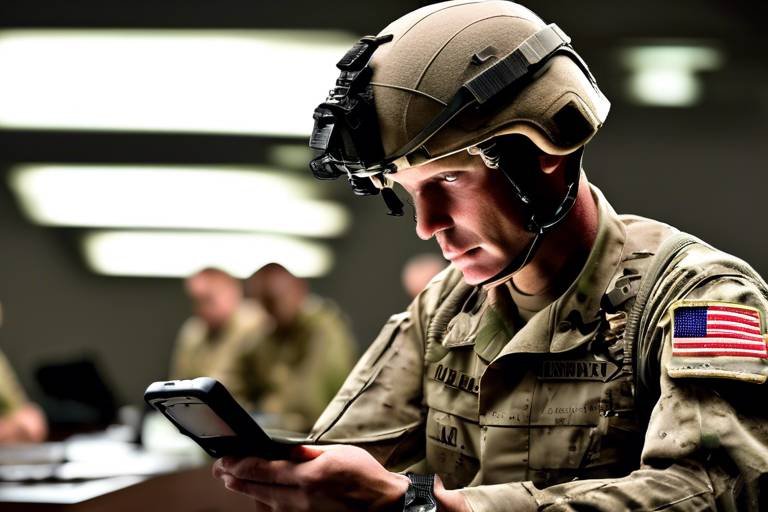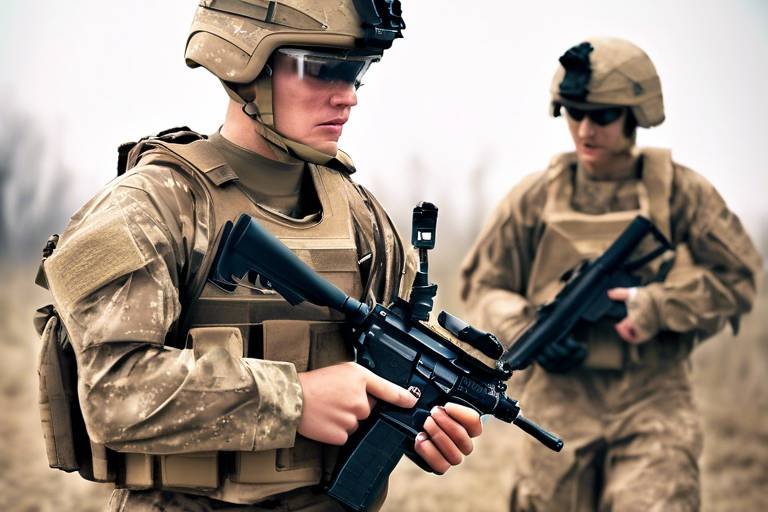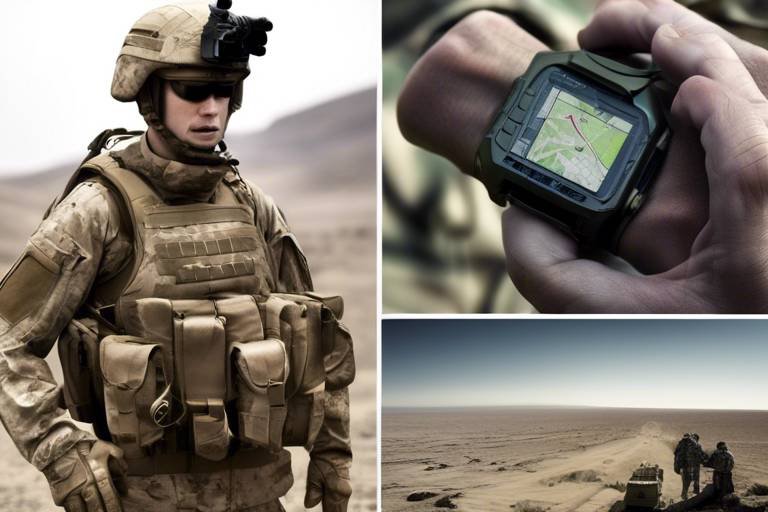How Smart Fabrics Are Enhancing Soldier Comfort
The modern battlefield is a complex environment that demands not only physical prowess but also mental resilience from soldiers. In this high-stakes arena, where every second counts, comfort can mean the difference between success and failure. Enter smart fabrics—an innovative solution that is revolutionizing the way military personnel experience their gear. These advanced textiles are not just about style; they are embedded with technology that dramatically enhances functionality, making them a game-changer for soldiers deployed in diverse and often challenging conditions.
So, what exactly are smart fabrics? Imagine a textile that can sense your body temperature, regulate moisture, and even communicate with other devices. Smart fabrics are textiles that integrate technology to provide enhanced performance. These fabrics can monitor physiological signals, respond to environmental changes, and offer features that traditional fabrics simply cannot match. In the military sector, this means soldiers can benefit from gear that adapts to their needs, ensuring they remain comfortable, safe, and effective in the field. The potential applications are vast, ranging from uniforms to tactical gear, and the implications for soldier performance are profound.
When it comes to the battlefield, the advantages of smart fabrics are numerous and significant. From temperature regulation to moisture management, these textiles are designed to improve soldier comfort and performance while minimizing distractions. Imagine being able to stay cool under pressure or dry during a grueling trek—smart fabrics make this possible. Let's delve deeper into some of the key benefits.
Maintaining an optimal body temperature is crucial for soldiers, especially when they find themselves in extreme climates. Smart fabrics are engineered to actively regulate temperature, ensuring that soldiers can perform at their best without the discomfort of overheating or feeling chilled. This is achieved through a combination of active cooling technologies and advanced insulation properties.
Active cooling technologies embedded within smart fabrics can significantly reduce heat stress, which is a common challenge in hot environments. These fabrics utilize phase change materials (PCMs) that absorb, store, and release heat as needed, effectively keeping the soldier cool. Imagine wearing a uniform that feels like air conditioning on a hot day—this innovation not only enhances comfort but also boosts endurance during missions.
Conversely, smart fabrics also offer impressive insulation to protect soldiers from cold environments. Utilizing materials that trap heat without adding bulk, these fabrics ensure that soldiers remain warm and agile. The combination of lightweight insulation and breathability allows for unrestricted movement, which is essential when every second counts in the field.
Effective moisture management is another critical aspect of soldier comfort. When soldiers exert themselves physically, sweating is inevitable. However, smart fabrics excel in wicking away moisture, keeping the skin dry and reducing the risk of discomfort and chafing. This is particularly important during long missions, where staying dry can significantly impact a soldier's focus and performance.
In the military, durability is non-negotiable. Smart fabrics are specifically designed to withstand harsh conditions, ensuring reliability in the field. These fabrics resist wear and tear while requiring minimal maintenance, which is a significant advantage for soldiers who may not have easy access to laundry facilities.
Smart fabrics are engineered to resist environmental factors such as water, dirt, and UV rays. This resistance is crucial for soldiers operating in diverse environments, from deserts to jungles. The ability to repel water and dirt means that soldiers can focus on their mission without worrying about their gear failing them at a critical moment.
One of the most fascinating innovations in smart fabrics is the integration of self-cleaning technologies. These fabrics utilize special coatings that break down dirt and bacteria when exposed to sunlight, allowing soldiers to maintain better hygiene without the need for frequent washing. This not only enhances personal comfort but also extends the life of the gear, making it a practical and efficient solution for military applications.
The future of smart fabrics in military applications is bright and full of potential. As advancements in materials science continue to evolve, we can expect to see even more innovative functionalities that will further enhance soldier comfort and effectiveness. From improved sensors that monitor health metrics to fabrics that can change color or pattern for camouflage, the possibilities are endless.
- What are smart fabrics? Smart fabrics are textiles that incorporate technology to enhance their functionality, such as temperature regulation and moisture management.
- How do smart fabrics help soldiers? They improve comfort and performance by regulating temperature, managing moisture, and providing durability under harsh conditions.
- Are smart fabrics easy to maintain? Yes, many smart fabrics are designed to be durable and require minimal maintenance, with some even featuring self-cleaning technologies.
- What is the future of smart fabrics in the military? The future is promising, with ongoing advancements in materials science leading to new functionalities that enhance soldier effectiveness and comfort.
Introduction to Smart Fabrics
Imagine a world where your clothing not only keeps you warm but also monitors your health and adapts to your environment. Smart fabrics are revolutionizing the way we think about textiles, especially in military applications. These innovative materials are embedded with technology that enhances their functionality, making them more than just ordinary fabric. From temperature regulation to moisture management, smart fabrics are designed to respond to the needs of the wearer, providing a level of comfort and performance that traditional fabrics simply cannot match.
At the core of smart fabrics is the principle of integrating technology into textiles. This integration can take many forms, including sensors that monitor body temperature, moisture levels, and even biometric data. Imagine a soldier in the field, their uniform equipped with sensors that provide real-time feedback on their physical condition. This kind of technology not only enhances comfort but also plays a crucial role in ensuring the soldier's safety and effectiveness during missions.
The potential applications of smart fabrics in the military sector are vast. For instance, these fabrics can be used to create uniforms that adjust to changing weather conditions, ensuring that soldiers remain comfortable regardless of the environment. Additionally, smart fabrics can be designed to be lightweight and durable, allowing for greater mobility and less fatigue during long missions.
As we delve deeper into the benefits of smart fabrics, it's essential to recognize their transformative impact on soldier comfort and performance. By leveraging the latest advancements in materials science and technology, the military can provide its personnel with gear that not only meets their needs but also enhances their overall effectiveness in the field. In the following sections, we'll explore the various advantages of smart fabrics, including their ability to regulate temperature and manage moisture, which are critical for maintaining soldier performance in diverse environments.
Benefits of Smart Fabrics for Soldiers
Smart fabrics are revolutionizing the way soldiers experience comfort and performance in the field. Imagine being able to adapt your clothing to the environment without having to change outfits or carry extra gear. These innovative textiles are designed to respond to various conditions, making them a game-changer for military applications. The benefits of smart fabrics can be categorized into several key areas, including temperature regulation, moisture management, and enhanced durability.
First and foremost, temperature regulation is critical for soldiers who often find themselves in extreme weather conditions. Whether it’s the sweltering heat of a desert or the biting cold of a mountain range, maintaining a stable body temperature can be the difference between success and failure in a mission. Smart fabrics utilize advanced materials that can actively adjust their thermal properties, keeping soldiers comfortable and focused on their tasks.
Another essential benefit is moisture management. Physical exertion leads to sweating, which can cause discomfort and even skin issues if not managed properly. Smart fabrics are engineered to wick moisture away from the skin, allowing it to evaporate quickly. This not only keeps soldiers dry but also reduces the risk of chafing and other irritations that can hinder performance. Imagine running a marathon in a fabric that keeps you dry and cool—this is what smart fabrics offer to soldiers during intense operations.
Durability is yet another significant advantage. Military gear must withstand harsh conditions, from mud and dirt to rain and UV rays. Smart fabrics are designed to be resilient, featuring coatings and treatments that enhance their resistance to environmental factors. For instance, many smart fabrics are water-resistant and can repel dirt, ensuring that soldiers can maintain their gear without constant washing. This is crucial when on long missions where access to laundry facilities is limited.
To illustrate the benefits of smart fabrics, consider the following table that summarizes their key features:
| Benefit | Description |
|---|---|
| Temperature Regulation | Active adjustment of thermal properties to maintain comfort in varying climates. |
| Moisture Management | Wicks away sweat to keep soldiers dry and reduce the risk of chafing. |
| Durability | Resistant to water, dirt, and UV rays, ensuring reliability in tough conditions. |
In conclusion, the integration of smart fabrics into military gear offers numerous advantages that significantly enhance soldier comfort and performance. By providing effective temperature regulation, moisture management, and exceptional durability, these fabrics allow soldiers to focus on their missions rather than their gear. The future of military apparel is undoubtedly tied to the advancements in smart fabric technology, promising even greater innovations down the line.
Q: What are smart fabrics?
A: Smart fabrics are textiles that incorporate technology to enhance their functionality, such as temperature regulation and moisture management.
Q: How do smart fabrics help with temperature regulation?
A: Smart fabrics use advanced materials that can adjust their thermal properties based on environmental conditions, helping to maintain a stable body temperature.
Q: Are smart fabrics durable enough for military use?
A: Yes, smart fabrics are engineered to be highly durable, resistant to water, dirt, and UV rays, making them suitable for harsh military environments.
Q: Can smart fabrics help prevent skin irritations?
A: Absolutely! Smart fabrics effectively wick moisture away from the skin, reducing sweat and the risk of chafing and other irritations.
Temperature Regulation
When it comes to soldier comfort, one of the most critical factors is . Imagine trudging through a scorching desert or navigating a frigid mountain range; the ability to maintain an optimal body temperature can make all the difference in performance and morale. Smart fabrics are designed with cutting-edge technology that actively regulates temperature, ensuring that soldiers remain comfortable and focused on their missions, rather than battling the elements.
These innovative materials utilize a combination of embedded sensors and advanced textiles to monitor body temperature and adjust accordingly. For instance, when a soldier begins to overheat, the smart fabric can activate cooling mechanisms that draw heat away from the body, effectively creating a microclimate that keeps the wearer comfortable. This is particularly beneficial during high-intensity activities, where heat stress can lead to fatigue and decreased performance.
Moreover, smart fabrics can also provide insulation in colder environments. Imagine wearing a jacket that not only keeps you warm but also adapts to your activity level. As soldiers engage in physical exertion, the insulation properties of these fabrics can adjust to ensure that they are not overheating during intense moments or becoming too cold during periods of inactivity. This dynamic response is made possible through the use of advanced materials that trap warmth when needed while allowing excess heat to escape.
To give you a clearer picture, here’s a table that summarizes how smart fabrics regulate temperature in various conditions:
| Condition | Smart Fabric Response |
|---|---|
| High Temperature | Activates cooling mechanisms to dissipate heat |
| Low Temperature | Enhances insulation to retain body heat |
| Variable Conditions | Automatically adjusts to maintain optimal temperature |
In conclusion, the ability of smart fabrics to regulate temperature is a game-changer for soldiers in the field. By integrating these advanced textiles into military gear, we can enhance not only comfort but also overall performance and safety. As technology continues to evolve, we can expect even more sophisticated solutions that will redefine how soldiers interact with their environments.
- What are smart fabrics? Smart fabrics are textiles that incorporate technology to enhance their functionality, such as temperature regulation and moisture management.
- How do smart fabrics regulate temperature? They use embedded sensors and advanced materials to monitor body temperature and adjust insulation or cooling mechanisms as needed.
- Can smart fabrics be used in extreme weather conditions? Yes, they are designed to perform well in both high and low temperatures, providing soldiers with comfort and protection.
Active Cooling Technologies
When it comes to the battlefield, heat stress can be a soldier's worst enemy. Imagine trudging through a desert, the sun beating down relentlessly, while your gear feels like a sauna. This is where embedded in smart fabrics come into play, revolutionizing how soldiers manage their body temperature. These technologies work by utilizing advanced materials and innovative designs that actively dissipate heat, ensuring that soldiers remain comfortable and focused on their missions.
One of the most exciting advancements in this area is the use of phase change materials (PCMs). These materials absorb, store, and release heat as they transition between solid and liquid states. When a soldier's body temperature rises, the PCM absorbs excess heat, preventing overheating. Conversely, when the temperature drops, the PCM releases stored heat, maintaining a stable and comfortable microclimate next to the skin. This dynamic response is akin to having a personal climate control system right within your uniform!
Moreover, some smart fabrics incorporate electronic cooling systems that use tiny, lightweight fans or thermoelectric devices to actively cool the fabric. These systems can be powered by small batteries or even solar panels, making them both practical and efficient. The integration of such technology means that soldiers can operate effectively in extreme heat without the debilitating effects of overheating. Think of it as wearing a miniature air conditioning unit—a game changer for anyone who has experienced the discomfort of excessive heat during physical exertion.
To illustrate the effectiveness of these active cooling technologies, consider the following table that compares traditional military uniforms with those utilizing smart fabrics:
| Feature | Traditional Uniforms | Smart Fabric Uniforms |
|---|---|---|
| Heat Dissipation | Passive | Active Cooling |
| Weight | Heavier | Lighter |
| Comfort Level | Variable | Consistent |
| Energy Source | N/A | Battery/Solar |
In addition to PCMs and electronic systems, some smart fabrics also utilize ventilation technologies that allow for increased airflow. These fabrics can have built-in channels or mesh-like structures that promote airflow, effectively reducing heat buildup. This is particularly crucial during high-intensity activities where sweat accumulation can lead to discomfort and distraction. By combining various active cooling methods, smart fabrics provide soldiers with a comprehensive solution to combat heat stress, enabling them to maintain peak performance even in the harshest conditions.
In conclusion, active cooling technologies represent a significant leap forward in military apparel. By integrating these innovative solutions into uniforms, we are not just enhancing comfort; we are actively improving the functionality and effectiveness of our soldiers on the field. The future of military gear is not just about protection; it’s about ensuring that our heroes can perform at their best, regardless of the environmental challenges they face.
Insulation Properties
When it comes to military operations, staying warm in cold environments is not just a matter of comfort—it's a matter of survival. Smart fabrics are revolutionizing the way soldiers experience insulation, allowing them to maintain core body temperature without the bulk of traditional thermal gear. Imagine wearing a lightweight jacket that feels like a second skin yet keeps you toasty warm even in freezing temperatures. This is the magic of modern smart fabrics!
These innovative textiles utilize a combination of advanced materials and technologies to provide superior insulation. For instance, some smart fabrics are designed with microfibers that trap air, creating a barrier against cold air while allowing moisture to escape. This dual action not only keeps soldiers warm but also prevents overheating, which can be a common issue during strenuous activities. Additionally, the use of phase change materials (PCMs) in these fabrics allows for dynamic temperature regulation. PCMs absorb, store, and release heat based on the body’s temperature fluctuations, ensuring that soldiers remain comfortable whether they are hunkered down in a snow-covered landscape or on the move.
Moreover, the insulation properties of smart fabrics are enhanced by their lightweight design. Traditional insulation materials can be bulky and cumbersome, hindering movement and agility. In contrast, smart fabrics are engineered to be thin yet effective, providing the warmth needed without sacrificing mobility. This is especially crucial in combat situations where every ounce of gear counts. The integration of insulation technology into smart fabrics is akin to having a high-performance sports car that combines speed with agility—maximizing efficiency while ensuring peak performance.
In addition to their thermal benefits, smart fabrics are often treated with water-resistant coatings, further enhancing their insulation capabilities. When soldiers are exposed to wet conditions, traditional insulation can lose its effectiveness, leading to chilling experiences. However, with smart fabrics, the combination of moisture-wicking properties and waterproof barriers means that soldiers can stay dry and warm, regardless of the weather. This is not just about comfort; it's about maintaining operational effectiveness in diverse and challenging environments.
As we look to the future, the potential for smart fabrics in military applications continues to expand. Researchers are exploring new materials and technologies that could enhance insulation properties even further, such as incorporating graphene for improved thermal conductivity or developing fabrics that can actively heat up when temperatures drop. The possibilities are endless, and the impact on soldier comfort and performance could be revolutionary.
- What are smart fabrics? Smart fabrics are textiles embedded with technology that enhances their functionality, such as temperature regulation, moisture management, and durability.
- How do smart fabrics help with insulation? They use advanced materials like microfibers and phase change materials to trap warmth without adding bulk, while also allowing moisture to escape.
- Are smart fabrics lightweight? Yes, smart fabrics are designed to be lightweight, providing effective insulation without hindering movement.
- Can smart fabrics keep soldiers dry? Absolutely! Many smart fabrics are treated with water-resistant coatings to help maintain dryness and warmth in wet conditions.
Moisture Management
When it comes to the battlefield, every detail counts, and one of the most crucial aspects of soldier comfort is . Picture this: you're in the middle of a mission, the sun is blazing, and you're drenched in sweat. Not only is this uncomfortable, but it can also lead to serious issues like chafing and hypothermia when temperatures drop. Smart fabrics are designed to tackle this problem head-on by utilizing advanced moisture-wicking technologies that keep soldiers dry and comfortable, no matter the conditions.
These innovative textiles work by drawing moisture away from the skin and allowing it to evaporate quickly. This is achieved through a combination of materials and engineering techniques that enhance breathability and evaporation rates. For instance, many smart fabrics incorporate hydrophobic fibers that repel water while simultaneously allowing sweat to escape. This dual action is essential for maintaining comfort during high-intensity activities, where moisture buildup can be a game-changer.
Moreover, moisture management is not just about keeping dry; it also plays a significant role in temperature regulation. When sweat evaporates efficiently, it cools the skin, helping to maintain an optimal body temperature. This becomes especially vital during long missions in hot climates, where overheating can severely impact a soldier's performance. With smart fabrics, soldiers can focus on their tasks without the distraction of discomfort caused by moisture.
To illustrate the effectiveness of these smart fabrics, let's take a look at a comparison of traditional fabrics versus smart fabrics in terms of moisture management:
| Feature | Traditional Fabrics | Smart Fabrics |
|---|---|---|
| Moisture Wicking | Poor | Excellent |
| Drying Time | Slow | Rapid |
| Comfort Level | Low | High |
| Chafing Risk | High | Low |
This table highlights how smart fabrics significantly outperform traditional materials in moisture management. By ensuring that soldiers remain dry and comfortable, these fabrics enhance overall performance and reduce the likelihood of injuries caused by prolonged exposure to moisture.
In conclusion, moisture management is a game-changer for soldiers on the field. With the integration of smart fabrics, the military is not just investing in clothing; it’s investing in the well-being and effectiveness of its personnel. As technology continues to advance, we can expect even more sophisticated solutions that will further elevate soldier comfort and performance.
Durability and Maintenance
When it comes to military gear, durability is not just a feature; it's a necessity. Soldiers operate in some of the most challenging environments imaginable, from scorching deserts to frigid mountains. This is where smart fabrics truly shine. Designed with advanced materials and engineering, these fabrics are built to withstand the rigors of military life. Think of them as the superheroes of textiles—resilient, tough, and ready to face anything.
One of the standout features of smart fabrics is their resistance to environmental factors. These fabrics are engineered to resist water, dirt, and UV rays, making them ideal for soldiers who often find themselves in unpredictable weather conditions. Imagine a soldier out in the field, drenched from a sudden rainstorm, only to realize that their uniform is not only waterproof but also breathable. This means they can stay dry and comfortable, which is vital for maintaining focus and performance.
Additionally, the integration of self-cleaning technologies in smart fabrics is a game changer. Traditional military uniforms require frequent washing, which can be a logistical nightmare in the field. However, with self-cleaning capabilities, these smart fabrics can repel dirt and stains, reducing the need for constant maintenance. This not only saves time but also enhances soldier hygiene, allowing them to focus on their mission rather than their gear. Imagine having a uniform that stays clean even after days of wear—now that's a comfort!
| Feature | Traditional Fabrics | Smart Fabrics |
|---|---|---|
| Water Resistance | Limited | High |
| Dirt Resistance | Low | High |
| UV Protection | Minimal | Enhanced |
| Self-Cleaning | No | Yes |
Moreover, the longevity of smart fabrics means that soldiers can rely on their gear for extended periods without the worry of wear and tear. This is particularly important in military operations where gear failure can have serious consequences. The materials used in smart fabrics are not only durable but also lightweight, ensuring that soldiers are not burdened by heavy clothing. In essence, smart fabrics offer a perfect balance of strength and comfort, allowing soldiers to perform at their best.
In conclusion, the durability and maintenance of smart fabrics represent a significant advancement in military technology. By combining resilience with self-cleaning properties, these fabrics not only enhance soldier comfort but also ensure that they remain focused on their mission. As we continue to explore the future of military applications, one thing is clear: smart fabrics are here to stay, and they are revolutionizing the way soldiers approach their gear.
- What are smart fabrics? Smart fabrics are textiles embedded with technology that enhances their functionality, making them suitable for various applications, including military use.
- How do smart fabrics improve soldier comfort? They regulate temperature, manage moisture, and offer durability, which collectively enhance comfort and performance in diverse environments.
- Are smart fabrics easy to maintain? Yes, many smart fabrics feature self-cleaning technologies, reducing the need for frequent washing and ensuring soldiers can focus on their missions.
- What is the future of smart fabrics in the military? The future looks promising, with ongoing advancements in materials science and potential new functionalities that could further enhance soldier effectiveness.
Resistance to Environmental Factors
When it comes to military operations, soldiers are often exposed to a myriad of environmental challenges. From torrential rain to scorching sun, the conditions can be brutal. This is where smart fabrics step in, designed not just for comfort but also to withstand these harsh elements. Imagine a fabric that can keep you dry during a downpour or protect you from harmful UV rays while you're on a reconnaissance mission. Sounds like science fiction, right? Well, it’s very much a reality today!
Smart fabrics are engineered with advanced materials that exhibit remarkable resistance to various environmental factors. For instance, many of these fabrics are treated with water-repellent coatings, allowing them to shed moisture effortlessly. This means that when a soldier is caught in the rain, their gear won’t become waterlogged, which can lead to discomfort and hypothermia. Instead, the fabric acts as a shield, keeping the wearer dry and focused on the mission at hand.
Moreover, the resistance to dirt and grime is another game-changer. In combat situations, soldiers often find themselves in muddy or dusty environments. Traditional fabrics can quickly become soiled, leading to hygiene issues and discomfort. However, smart fabrics are designed to resist dirt accumulation, which not only keeps them looking clean but also minimizes the risk of skin irritations and infections. This is particularly crucial when soldiers are deployed in remote areas where access to clean water for washing is limited.
Another notable feature of these innovative textiles is their ability to block harmful UV rays. Prolonged exposure to the sun can lead to serious skin conditions, but smart fabrics can incorporate UV-blocking technologies that protect soldiers from these dangers. This is essential for those who may be stationed in sunny climates for extended periods. By integrating these protective elements, smart fabrics ensure that soldiers can perform their duties without the constant worry of environmental hazards.
To summarize, the resistance of smart fabrics to environmental factors is a significant advancement in military gear. They are designed to keep soldiers dry, clean, and protected from harmful elements, allowing them to maintain focus and performance in the field. As technology continues to evolve, we can expect even more enhancements that will further boost the resilience of these fabrics against the unpredictable nature of military operations.
Self-Cleaning Technologies
Imagine a world where your military gear stays clean without the hassle of frequent washing. in smart fabrics are making this dream a reality. These cutting-edge innovations utilize advanced materials and coatings that repel dirt, moisture, and even stains. This means that soldiers can focus on their mission rather than worrying about their uniforms. The technology works by employing nanotechnology to create surfaces that are highly resistant to contaminants. When dirt or liquids come into contact with these fabrics, they simply slide off, keeping the material clean and functional.
One of the most exciting aspects of self-cleaning fabrics is their potential to enhance soldier hygiene. In the field, maintaining cleanliness is not just about comfort; it’s also about health. Traditional fabrics can harbor bacteria and odors, which can be detrimental during long missions. However, smart fabrics with self-cleaning properties actively reduce the accumulation of these harmful elements. For example, some fabrics are treated with special coatings that release antimicrobial agents, ensuring that soldiers stay fresh and protected from infections.
Moreover, the self-cleaning feature contributes to the overall longevity of military gear. With reduced need for washing, the wear and tear on the fabric is minimized, allowing soldiers to rely on their gear for extended periods. This durability is especially crucial when operating in remote locations where laundry facilities are non-existent. The table below summarizes the key benefits of self-cleaning technologies in smart fabrics:
| Benefit | Description |
|---|---|
| Hygiene | Reduces bacteria and odor accumulation |
| Durability | Minimizes wear from frequent washing |
| Convenience | Less time spent on laundry, more time on missions |
In essence, self-cleaning technologies in smart fabrics represent a significant leap forward in military apparel. They not only enhance the comfort and hygiene of soldiers but also extend the lifespan of their gear. As the military continues to seek innovative solutions to support its personnel, self-cleaning fabrics stand out as a remarkable advancement that combines science with practical applications.
- What are smart fabrics? Smart fabrics are textiles embedded with technology that enhances their functionality, such as temperature regulation and moisture management.
- How do self-cleaning fabrics work? They use advanced coatings and nanotechnology to repel dirt and moisture, allowing contaminants to slide off easily.
- What are the benefits of self-cleaning technologies for soldiers? They improve hygiene, reduce gear maintenance, and enhance overall comfort during missions.
- Can self-cleaning fabrics withstand harsh environments? Yes, these fabrics are designed to be durable and resistant to various environmental factors.
Future Trends in Smart Fabric Technology
As we look to the horizon of military innovation, the future of smart fabrics is nothing short of exciting. The integration of advanced technologies into textiles is poised to transform how soldiers experience comfort and functionality in the field. One of the most promising trends is the development of adaptive materials that can change their properties based on environmental conditions. Imagine a fabric that can sense temperature fluctuations and adjust its insulation levels accordingly! This adaptability could revolutionize how soldiers manage their comfort in extreme climates.
Moreover, the incorporation of wearable technology into smart fabrics is gaining traction. These textiles can monitor vital signs, track physical exertion, and even assess environmental hazards. For instance, a soldier's uniform could provide real-time feedback about their heart rate and hydration levels, alerting them to potential health risks before they become critical. This kind of integration not only enhances safety but also empowers soldiers to make informed decisions about their well-being.
Another exciting development is the potential for biodegradable smart fabrics. With growing concerns about environmental sustainability, researchers are exploring materials that can decompose after their lifecycle ends. This would significantly reduce the ecological footprint of military operations, aligning with broader goals of environmental responsibility. Imagine uniforms that serve their purpose and then return to the earth without leaving a trace!
To illustrate these trends, consider the following table that outlines some of the anticipated advancements in smart fabric technology:
| Trend | Description | Potential Impact |
|---|---|---|
| Adaptive Materials | Fabrics that adjust insulation and breathability based on temperature. | Enhanced comfort in extreme conditions. |
| Wearable Technology Integration | Textiles that monitor health metrics and environmental conditions. | Improved soldier safety and health management. |
| Biodegradable Fabrics | Materials that decompose after use to minimize environmental impact. | Reduction in ecological footprint of military gear. |
Lastly, the use of smart fabrics in communication technologies is on the rise. Future uniforms could potentially integrate communication devices directly into the fabric, allowing for seamless connectivity without the need for bulky equipment. This would not only streamline operations but also enhance the overall effectiveness of military missions.
In summary, the future of smart fabric technology in military applications is bright and filled with potential. As these innovations continue to develop, we can expect significant improvements in soldier comfort, performance, and safety, ultimately leading to a more effective military force.
- What are smart fabrics?
Smart fabrics are textiles that incorporate technology to enhance their functionality, such as temperature regulation, moisture management, and more. - How do smart fabrics benefit soldiers?
They improve comfort by regulating temperature, managing moisture, and increasing durability, allowing soldiers to perform better in various environments. - What future technologies are being integrated into smart fabrics?
Future technologies include adaptive materials, wearable tech for health monitoring, biodegradable fabrics, and integrated communication devices.
Frequently Asked Questions
- What are smart fabrics?
Smart fabrics are innovative textiles that incorporate technology to enhance their functionality. They can respond to environmental changes, providing features like temperature regulation, moisture management, and even self-cleaning properties, making them particularly beneficial for military applications.
- How do smart fabrics improve soldier comfort?
Smart fabrics enhance soldier comfort by actively regulating body temperature, managing moisture, and offering durable protection against harsh conditions. This means soldiers can focus on their missions without being distracted by discomfort from overheating or dampness.
- What technologies are used for temperature regulation in smart fabrics?
Temperature regulation in smart fabrics often involves active cooling technologies that help dissipate heat and insulation materials that retain warmth without adding bulk. This ensures soldiers stay comfortable in both hot and cold environments.
- How do smart fabrics manage moisture?
Smart fabrics are designed to wick away sweat and moisture, keeping the wearer dry and comfortable. This moisture management reduces the risk of chafing and discomfort during physical exertion, which is crucial for soldiers in the field.
- Are smart fabrics durable enough for military use?
Absolutely! Smart fabrics are engineered to withstand harsh conditions, including water, dirt, and UV exposure. Their durability ensures that soldiers can rely on their gear in diverse environments without worrying about wear and tear.
- What is self-cleaning technology in smart fabrics?
Self-cleaning technology in smart fabrics allows them to repel dirt and stains, reducing the need for frequent washing. This not only enhances hygiene but also extends the lifespan of the gear, making it more efficient for soldiers.
- What are the future trends in smart fabric technology?
The future of smart fabrics looks bright, with ongoing advancements in materials science. Emerging trends may include even more sophisticated functionalities, such as integrated sensors for health monitoring or enhanced adaptability to various environmental conditions.




